- Getting around Lijiang. Dont stay in the Old Towns more than 2 days, there is nothing to do. KRISS Oct 9, 2013 05:46
- 2013 Beijing Temple Fair BENNYLAU Feb 26, 2013 03:29
- Malaysian traveling from KUL - LAX vis Shanghai PVG ZATI_DY Jan 3, 2013 20:15
Seeing Shanghai
- Views: 9618
- |Vote: 0 0
- |Add to Favorites
- |Recommend to Friends
Why I’ve never been to Shanghai before
Expectations are a tricky thing: equally capable of being a barrier between or the impetus towards experience. I realised this when, after over 18 months in China, I finally decided to visit Shanghai. Why had it taken me so long to visit a city that is not only famous in China, but has a place in worldwide consciousness ? The answer: expectations, and my expectations, to be precise.
Shanghai has always fallen victim to two of my harshest and least forgiving expectations:
1) It is just a city: polluted, noisy, over-vehicled and over-peopled
2) It is heavily influenced by “the West”: I came to China to see China, not another “Western” city.
Hence, I had only the smallest of desires to see it.
Moving to the south of China, and only a few hours away from this metropolis, it was dubious as to how long my “not going” to Shanghai could be sustained. When a new friend and newcomer to China expressed her desire to go and see the Pearl of the Orient, it seemed I had run out of excuses. The surge of excitement I get with the possibility of travel kicked in and as the weekend trip came closer, I began re-evaluating my thoughts on Shanghai.
Not travelling alone, and being limited on time meant that an itinerary was called for and we agreed to visit the Yuyuan Garden and Bazaar [豫园商城], the Jade Buddha Temple [玉佛寺] and The Bund [外滩]. Sat on the bus with Opal, Shanghai bound, I had many ideas; the most intriguing being that perhaps, beyond hope, the city might dash all negative expectations to pieces and thrill me as it did so many others: Chinese and non-Chinese alike.
[Image: Downtown Shanghai After The Rain]
Shanghai: From Feet to a Futuristic TV Tower
Shanghai is just a city. This is not a criticism. What I’ve learned is that a city must be seen for what it is, and Shanghai, of all cities, makes no apologies for being such. Even in this innocuous weekend in late October, the first thing that grabbed me was the sheer volume of people, and traffic. Shanghai was a seething, bustling, frenzied place where even the pace of feet on the street marched to a faster beat. There was also a sense of importance in these feet – did it come from the streets themselves ? I felt it in my own feet, that sense that I was walking not just anywhere, but in Shanghai! The overwhelming presence of Shanghai transcended the city itself and inhabited my blood, much as I remembered London did on my first visit so many years ago.
The skies were, predictably, cloudy. We walked in the back streets behind the Bund to locate our hotel and it was here that I think I first saw Shanghai. A continual stream of feet, bicycle wheels, taxis, buses, street signs, traffic lights, power cables and urbanity flowed beneath the circles and spikes of the Oriental Pearl Tower [东方明珠电视塔]. Almost as grey as the sky it pierces, pearlescent-pink balls aside, it reminded me a little of Thunderbird One and I wondered what it was doing here. But I remembered that this is Shanghai, a city where anything futuristic goes and apparently an architect can dress space however they please. Somehow this fusion of the urban and the alien seemed perfectly Shanghai!
[Image: Oriental Pearl Tower Overlooking Shanghai Streets]
The Yuyuan Garden and Bazaar Area
The Yuyuan Garden and Bazaar area is a tourist and foodies paradise, a maze of paved streets with a courtyard feel, hemmed in by newly-built old-style buildings and an almost 50/50 ratio of foreign and domestic tourists. Originally it was part of the old city of Shanghai, bits and pieces of which remain scattered in this area in narrow, hanging-laundry crossed alleys. I would suggest a walk through them for anyone who has the time and inclination to find them out.
The Bazaar is nevertheless worthy of exploration if only to try the fattening array of snacks on offer. We tried the tasty soup dumplings [小笼包] half for the fun of sucking the meaty “soup” through a straw. Sweet and savoury delights abound between souvenir shops and high priced restaurants. An eager shop owner whose shop we stopped at to admire the silk clothing was desperate for us to buy, reducing a nightgown by several hundred RMB from her first offer to around 50. Bargaining, at least outside of the peak season, should be relatively easy for those looking to buy – don’t be afraid to try it – and if you walk away there’s a good chance the vendor will come after you.
[Image: 2 Soupy Dumplings With Straws]
A Bridge of Bends and a Teahouse With Royal Connections
The Yuyuan Garden itself lies at the heart of this area across the many bends of the Bridge of Nine Turns. These “zigzags” are to thwart all evil spirits (who are incapable of passing around corners) from entering the gardens and it’s not difficult to see why! Negotiating the bridge is made more pleasant by the grand, colourful Koi swimming in the pool beneath.
To the side of the gardens and originally a part of them is the Mid-Lake Pavilion Teahouse [湖心亭] rising in restored Ming-architectural glory and rumoured to be the inspiration behind the famous Willow Pattern pottery design. The Willow Pattern first appeared from drawings in England in 1770 depicting a Chinese-style teahouse, cranes, trees and pools and is still popular today. The teahouse retains its own fame in contemporary times through its guest list that includes the likes of Queen Elizabeth II and former US president Bill Clinton.
[Image: Windowcleaner And Ming-Styled Teahouse]
Yuyuan Garden: Pathways, Pools, Plants and Pavilions
Having been painstakingly built over a period of 18 years from 1559 the Yuyuan Garden stood as a triumph of Ming Dynasty garden design until it was ruined during the 19th Century Opium Wars. Fortunately it has now been restored to its former elegant beauty and covers around 2 hectares with meandering pathways, pools, plants and pavilions.
Being a former student of garden design I was entranced with the delicacy and intricacy: the way the design never lets anything other than a small taste of the garden delight the senses at any one moment. The planting is rich and varied: from the typical, though nevertheless exquisite cloud-pruned trees and shrubs, to the feathery fingers of maples and bamboos, the tropical fat-leaved bananas to the prehistoric, mammoth-sized ginkgo, the round water lilies to the spiky cycads.
For those not interested in plants, it’s still easy to lose yourself for a while amidst the abundant greenery. The garden is host to around 30 pavilions and an outdoor theatre stage with a carved ceiling, said to have superb acoustics. There are also innumerable rock gardens interlaced with pools, ponds, streams, bridges, stepping-stones and covered walkways. Courtyards are surrounded by white walls with carved windows and dragons top the roofs and outer walls.
My only disappointment concerned the huge number of people that surged through the garden – of which I know I was also one – and the great noise we brought with us. The garden deserves silence, from where the murmur of the stream and the wind in the bamboos becomes a symphony. That kind of quietness, in Shanghai, city of Chinese cities, must be impossible but it is a testament to the garden that it filters out much of the pace of city life and peaceful corners can be found, here and there, if you look hard enough.
[Image: A Quiet Corner In The Garden]
The Jade Buddha Temple: An Oddly Empty Encounter
Opal, my companion, wanted to see the Jade Buddha Temple, as it is listed as one of the only active Buddhist Temples in Shanghai. This, and the prospect of seeing the 2m high white jade Buddha, were enough to put it on our itinerary and saw us on a rainy Saturday outside the gates. Cars, buses and people thronged the side road but proved to be nothing compared with the numbers inside the temple complex itself.
We wandered the interior of the temple in a kind of awe forced upon us by trying to find something like an authentic atmosphere in the midst of so many people, tour groups and loud halers. Opal had not had the previous experiences I had of deserted temples in far off provinces, where empty halls listened to the swish of a monk’s robes and men with lined faces spun prayer wheels, but even so she was struck by the “touristy” nature of this place: the souvenir shops and on-the-hour-every-hour “performance” of monks trooping through the grounds to music.
For an extra fee, you can ascend the wooden steps and follow the conveyor belt of others moving past the white Buddha. Buddha dwells in a darkened room, thick with incense, golden artefacts and plastic flowers and sits at least 10 metres away from us onlookers, watching us pass by from calm, milky eyes. A stall, positioned directly in front of the Buddha, catering to believers and unbelievers alike, sells incense sticks and picture postcards. Some come here to pray or look to be blessed but we both found it a most un-spiritual and oddly empty encounter.
[Image: People, And A Temple]
The Muddy Waterfront at Night
The word “Bund” itself is definitive of Shanghai. From its Anglo-Indian meaning as muddy waterfront which hints prophetically at the fact that every year Shanghai is sinking under its own weight to the muddy history of the area equivalent to New York’s Wall Street where the first foreigners purchased land and wheeler-dealers revelled in opium and tea. The Bund is now slowly but surely being reclaimed with domestic and foreign companies occupying its extravagant frontages… neatly imitating history.
Most cities, even the ugly ones, look better at night. For the one evening I spent in Shanghai I was more than happy therefore to stroll along the ultra-famous Bund and look out over the river. It was a magnificent evening, the sky was blue-grey and the crowds had diminished, I walked and watched still permeated by the shock of Shanghai. In truth, I was simultaneously spellbound and scared by a skyline as futuristic and photogenic as any in the world and the energy required to maintain it. Couples posed for pictures against this wonderland backdrop of famous brands and 5-star hotels whilst roller-blading children manoeuvred in and out of them.
Whilst the Saturday night designer-clothes-clad contingent were out spending large in this bar and club bedazzled city, I was watching Yao Ming (Chinese basketball superstar) cruising along the Huangpu [黄浦江]. There he was, even larger than his real life self, grinning out from an enormous TV screen mounted on a barge and floating up and down. It circulated an endlessly repeating series of advertisements beneath the super-modern glow of the far side of the river.
[Image: View From The Bund At Night]
Seeing Shanghai
Expectations were where I began this article and where I should end. Shanghai is a city that does what it says it will do, it both proved true every bad expectation I had as firmly as it confirmed every good one. If nothing else here is a city that crackles with energy and life and personifies, perhaps like no-where else in China, the glorious mess where East meets West.
The walk from the Bund back to my hotel was about 20 minutes and took me past a street devoted entirely to weddings. As many windows shone with the bright white wedding gowns I might see at home as the red silks of a traditional Chinese-style dress. On the pavement, the strains of a waltz sang out from an old tape player and couples young, old and older danced along. A man selling pirated DVDs from his bicycle basket smoked and watched.
This was, I felt, seeing Shanghai.
[Image: Backstreets Of Shanghai]
Information (October 2006)
Getting there.
(Whilst it’s unlikely you’ll be travelling from Lin’an, this is how I got there)
To: Shanghai 【上海】
From:Lin’an 【临安】
By: Bus (direct)
Costs: 70RMB
Accommodation
Jinjiang Inn 【锦江之星】
33 Fujian Road South, The Bund, Shanghai 【上海市福建南路33号】
This chain of Inns I have not used before, but it was clean and the staff spoke English and were helpful. A twin room with en-suite bathroom and air-conditioning was 120RMB per person/per night. This Inn is close to the river and Yuyuan Gardens – about 20 minutes walk away.
Attractions
Yuyuan Garden 【豫园商城】
Entrance fee: 40RMB
Jade Buddha Temple 【玉佛寺】
Temple Entrance Fee: 15RMB
To view Jade Buddha: 10RMB
[Image: On The Shanghai Subway Train]



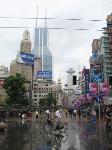
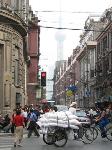


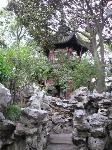

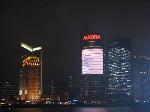
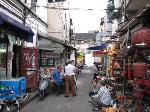

 Copyright © 1998-2025 All rights reserved.
Copyright © 1998-2025 All rights reserved.
1.
Dec 24, 2007 03:11 Reply
WESTNORWOODGAS said:
I'm glad I read these comments, I'm really looking forward to seeing for myself this famous city.
Alan
2.
Mar 31, 2007 00:33 Reply
CHYNAGYRL said:
This was a nice article -- thank you for sharing your experience of Shanghai. I generally avoid big cities as well although they are interesting for a visit.
3.
Mar 30, 2007 14:51 Reply
KEMILAW said:
hi
i have never been to china before but i will be there this April,visiting Ningbo but am staying in Shangai for 5night, Kindly let me know if i can get an appartment where i woulod be able to do my own cooking.